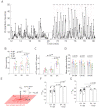Spontaneous and evoked activity patterns diverge over development
- PMID: 33871351
- PMCID: PMC8075578
- DOI: 10.7554/eLife.61942
Spontaneous and evoked activity patterns diverge over development
Abstract
The immature brain is highly spontaneously active. Over development this activity must be integrated with emerging patterns of stimulus-evoked activity, but little is known about how this occurs. Here we investigated this question by recording spontaneous and evoked neural activity in the larval zebrafish tectum from 4 to 15 days post-fertilisation. Correlations within spontaneous and evoked activity epochs were comparable over development, and their neural assemblies refined in similar ways. However, both the similarity between evoked and spontaneous assemblies, and also the geometric distance between spontaneous and evoked patterns, decreased over development. At all stages of development, evoked activity was of higher dimension than spontaneous activity. Thus, spontaneous and evoked activity do not converge over development in this system, and these results do not support the hypothesis that spontaneous activity evolves to form a Bayesian prior for evoked activity.
Keywords: neural coding; neural development; neuroscience; spontaneous activity; zebrafish.
© 2021, Avitan et al.
Conflict of interest statement
LA, ZP, JM, SZ, BS, GG No competing interests declared
Figures






References
Publication types
MeSH terms
Substances
Grants and funding
LinkOut - more resources
Full Text Sources
Other Literature Sources
Molecular Biology Databases

